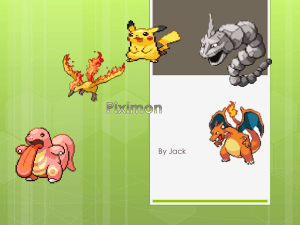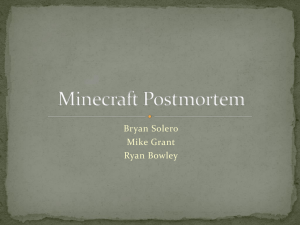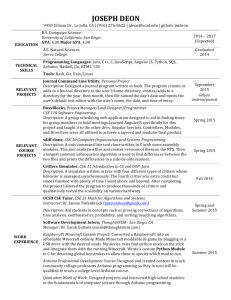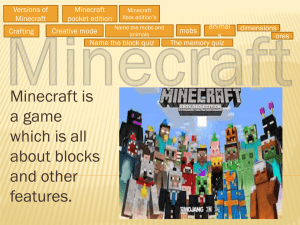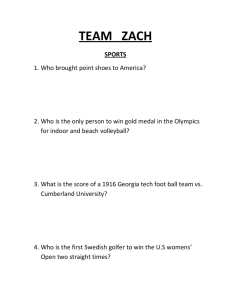Minecraft Mania!
advertisement
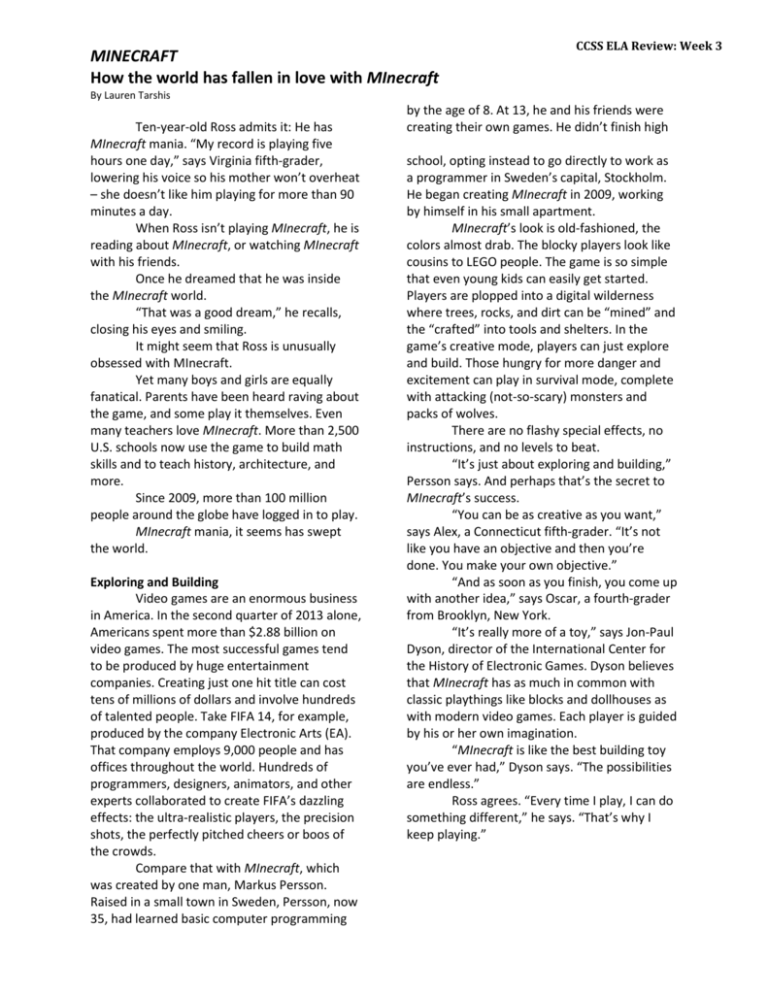
MINECRAFT How the world has fallen in love with MInecraft CCSS ELA Review: Week 3 By Lauren Tarshis Ten-year-old Ross admits it: He has MInecraft mania. “My record is playing five hours one day,” says Virginia fifth-grader, lowering his voice so his mother won’t overheat – she doesn’t like him playing for more than 90 minutes a day. When Ross isn’t playing MInecraft, he is reading about MInecraft, or watching MInecraft with his friends. Once he dreamed that he was inside the MInecraft world. “That was a good dream,” he recalls, closing his eyes and smiling. It might seem that Ross is unusually obsessed with MInecraft. Yet many boys and girls are equally fanatical. Parents have been heard raving about the game, and some play it themselves. Even many teachers love MInecraft. More than 2,500 U.S. schools now use the game to build math skills and to teach history, architecture, and more. Since 2009, more than 100 million people around the globe have logged in to play. MInecraft mania, it seems has swept the world. Exploring and Building Video games are an enormous business in America. In the second quarter of 2013 alone, Americans spent more than $2.88 billion on video games. The most successful games tend to be produced by huge entertainment companies. Creating just one hit title can cost tens of millions of dollars and involve hundreds of talented people. Take FIFA 14, for example, produced by the company Electronic Arts (EA). That company employs 9,000 people and has offices throughout the world. Hundreds of programmers, designers, animators, and other experts collaborated to create FIFA’s dazzling effects: the ultra-realistic players, the precision shots, the perfectly pitched cheers or boos of the crowds. Compare that with MInecraft, which was created by one man, Markus Persson. Raised in a small town in Sweden, Persson, now 35, had learned basic computer programming by the age of 8. At 13, he and his friends were creating their own games. He didn’t finish high school, opting instead to go directly to work as a programmer in Sweden’s capital, Stockholm. He began creating MInecraft in 2009, working by himself in his small apartment. MInecraft’s look is old-fashioned, the colors almost drab. The blocky players look like cousins to LEGO people. The game is so simple that even young kids can easily get started. Players are plopped into a digital wilderness where trees, rocks, and dirt can be “mined” and the “crafted” into tools and shelters. In the game’s creative mode, players can just explore and build. Those hungry for more danger and excitement can play in survival mode, complete with attacking (not-so-scary) monsters and packs of wolves. There are no flashy special effects, no instructions, and no levels to beat. “It’s just about exploring and building,” Persson says. And perhaps that’s the secret to MInecraft’s success. “You can be as creative as you want,” says Alex, a Connecticut fifth-grader. “It’s not like you have an objective and then you’re done. You make your own objective.” “And as soon as you finish, you come up with another idea,” says Oscar, a fourth-grader from Brooklyn, New York. “It’s really more of a toy,” says Jon-Paul Dyson, director of the International Center for the History of Electronic Games. Dyson believes that MInecraft has as much in common with classic playthings like blocks and dollhouses as with modern video games. Each player is guided by his or her own imagination. “MInecraft is like the best building toy you’ve ever had,” Dyson says. “The possibilities are endless.” Ross agrees. “Every time I play, I can do something different,” he says. “That’s why I keep playing.” CCSS ELA Review: Week 3 INFORMATIONAL TEXT 400 Billion LEGO Bricks – and Still Counting By Lela Nargi 1931 was not an easy year for Ole Kirk Kristiansen, a carpenter living in a small village in Denmark. Like many people, Ole and his family were suffering in the midst of a worldwide economic disaster known as the Great Depression. Ole had three small sons to support, and his wife was expecting their fourth child. The future seemed bleak – and racked with hunger. A Growing Business Ole was rich in one thing, though: wood. His village, Billund, was surrounded by a forest with birch trees. Ole used his wood to make ladders and stools. He created them in miniature first, to get their designers just right. That’s how he hit on the idea of building toys: Even poor farmers could afford to few toys at Christmastime. Ole drove from town to town looking for buyers for his wooden trucks and animals. Often he accepted food for payment. The decades passed, and his business grew. Ole started making toys out of plastic. It was cheap, and it didn’t peel or chip. Ole’s son Godtfred worked with his father in the company. It was his idea to create a set of plastic blocks that an imaginative kid could use to build and rebuild. Ole loved the idea. They called their invention LEGO bricks. A Flop at First The first LEGO bricks were a flop. They were simply hollow plastic squares, and they came apart too easily. What the bricks needed was “clutch power” – the ability to cling to each other until small hands pried them apart. Godtfred’s solution: bricks and studs on top and tubes underneath. In 1958, they released Town Plan, one of the first LEGO sets. Ole died just a few months later. Play Well It’s safe to say that the LEGO brand has succeeded beyond Ole’s wildest dreams. Over the past 56 years, the company has produced more than 400 billion LEGO bricks – 62 for every person on Earth. There are thousands of different LEGO sets, LEGO them parks, a hit movie, video games, and more. And yet the company’s vision remains as simple as it was when Ole was making blocks out of birch trees from the Danish forest. The word lego comes from the Danish term leg godt. It means, “play well.” CCSS ELA Review: Week 3 Directions: Answer the questions in the left-hand column using information from “Minecraft Mania!” and “400 Billion LEGO Bricks – and Still Counting.” Then check the appropriate box to indicate if the answers are similar or different. Minecraft How many people were involved in the creation? How did the company that makes it get started? Does it require technology? Are there rules for how to play? Is the brand successful? Explain. Why do people like it so much? LEGO® bricks Similar Different CCSS ELA Review: Week 3 Making Inferences Directions: The chart below list clues from “Minecraft Mania!” on the left and inferences you can make from them on the right. Fill in the blank on the chart with clues or inferences from the article. Clues Consider these lines form the article: “Parents have been heard raving about the game, and some play it themselves.” “Even many teachers love Minecraft.” “More than 2,500 U.S. schools now use the game to build math skills and to teach history, architecture, and more.” Inferences What can you infer is unusual about Minecraft’s popularity? _________________________________ _________________________________ _________________________________ _________________________________ Write two sentences from the article that supports the inference on the right. _________________________________ _________________________________ _________________________________ _________________________________ _________________________________ _________________________________ _________________________________ _________________________________ Consider these lines from the informational text: “Ole had three small sons to support, and his wife was expecting their forth child. The future seemed bleak – and racked with hunger.” “Ole was rich in one thing, though: wood.” Write one more line from the article that supports the inference on the right. _________________________________ _________________________________ _________________________________ _________________________________ You can infer the Minecraft is popular because it is different from other video games. What can you infer about how difficult circumstances affected Ole? _________________________________ _________________________________ _________________________________ _________________________________ CCSS ELA Review: Week 3 “Minecraft Mania!” Quiz Directions: Read the paired text “Minecraft Mania!” and “400 Billion LEGO Bricks – and Still Counting. “Then fill in the bubble next to the best answer for each question below. 1. Which of the following sentences states a main idea of the article “Minecraft Mania!”? a. Minecraft was created by Markus Persson. b. Minecraft is a very popular video game. c. The monsters in Minecraft aren’t very scary. d. Minecraft is not for young children. 5. According to the text, schools use Minecraft to teach – a. architecture b. history c. math d. all of the above 2. Which line from the article supports the answer to question 1? a. “Since 2009, more than 100 million people around the globe have logged in to play.” b. “Once he dreamed that he was inside the Minecraft world.” c. “’It’s just about exploring and building’.” d. “’It’s really more of a toy.’” 6. What difference does the author of “Minecraft Mania!” point out between FIFA 2014 and Minecraft? a. One is popular; the other is unpopular. b. One was created by a huge company, the other by a single person. c. One is for adults, the other for kids. d. One is for multiple players, the other for a single player. 3. The article suggests that Minecraft is popular because it – a. has packs of wolves. b. lets players create c. involve LEGO® bricks d. is funny 4. Which line from the text supports the answer to question 3? a. “’My record is playing five hours one day.’” b. “’That was a good dream.’” c. “Even many teachers love Minecraft.” d. “’Minecraft is like the best building toy you’ve ever had.’” 7. Which of the statements below is supported by both articles? a. Video games are a big business. b. LEGO bricks have been around for more than 100 years. c. Minecraft has an old-fashioned look. d. Many people enjoy playing creativity. 8. Based on “400 Billion LEGO Bricks – and Still Counting,” Ole and Godtfred Kristiansen could be described as – a. generous b. cautious c. pushy d. inventive 9. Most texts are written to persuade, inform, or entertain. What do you think is the purpose of “Minecraft Mania!”? 10. In what ways is Minecraft similar to LEGO bricks? CCSS ELA Review: Week 3 Vocabulary drab (adjective) very dull and dreary economic (adjective) having to do with money and how it is earned and used precision (noun) the quality of being very accurate or exact opting (verb) choosing fanatical (adjective) wildly enthusiastic Directions: Select the best answer to each question below. 1. Which of the following could cause a fanatical response? a. a sports team winning a big game b. a famous singer releasing a new song c. a beloved author signing books at a local bookstore d. all of the above 2. Select the best sentence to follow this “Jaden knew her new school would pose some economic challenges.” a. “She would have to work hard to keep her grades at a high level.” b. “It was an expensive school, and she didn’t know how her parents would pay for it.” c. “She didn’t know any of the students and would need to work on making friends.” d. “She loved soccer but knew making the team would be difficult.” 3. For which of these would drab be a good description? a. a field of blooming flowers b. a polka-dot sweater c. a highly detailed pencil sketch d. a beige wall 4. Which of the following does NOT mean the same as opting? a. selecting b. picking c. forcing d. electing 5. Which of the following activities most requires precision? a. designing a bridge b. creating a painting c. writing a song d. reading a novel 6. Describe something drab. Why do you consider it drab? 7. Use two of the five vocabulary words in a sentence: ANSWER KEY - Vocabulary 1. D 2. B 3. D 4. C 5. A 6. Answers will vary. 7. Answers will vary. CCSS ELA Review: Week 3 ANSWER KEY - Inference 1. You can infer that Minecraft has become popular with audiences you wouldn’t expect to love a video game, including parents, teachers, and school leaders. 2. Two sentences that support the inference are: “Minecraft’s look is old-fashioned, the colors almost drab,” and “’It’s just about exploring and building,’ Persson says.” 3. You can infer that difficult circumstances can force people to think creatively to solve problems, making use of what is available to them. 4. Two sentences that support the inference are: “There are no flashy special effects, no instructions, no levels to beat,” and “And yet company’s vision remains as simple as it was when Ole was making blocks out of birch trees from the Danish forest.” (Answers will vary) ANSWER KEY - Quiz 1. B (main idea; R2) 2. A (text evidence; R1) 3. B (inference; R1) 4. D (text evidence; R1) 5. D (key detail; R2) 6. B (compare and contrast; R9) 7. D (synthesizing; R9) 8. D (character trait; R1) 9. The article’s main purpose is to inform. The author mainly explains how Minecraft was developed and why it has become such a popular game. (author’s purpose; R6) 10. Both Minecraft and LEGO bricks are very popular. Both allow people to play creatively. Both were invented by just one or two people using simple resources. (synthesizing/compare and contrast; R9) CCSS ELA Review: Week 3 Directions: Answer the questions in the left-hand column using information from “Minecraft Mania!” and “400 Billion LEGO Bricks – and Still Counting.” Then check the appropriate box to indicate if the answers are similar or different. How many people were involved in the creation? Minecraft One person, Markus Perrson, created it. LEGO® bricks Two people Ole Kirk Kristansen and his son Godtfred, invented them. Similar Different X How did the company that makes it get started? Markus Persson was a computer programmer who Ole Kirk Kristansen was a carpenter who made liked creating his own games. He invented Minecraft miniature furniture as models. He decided to sell at his kitchen table.. them as toys because his family was desperate for money. Does it require technology? Yes X No X Are there rules for how to play? No No Is the brand successful? Explain. Yes. Both kids and adults love it. More than 100 million people around the globe have played since 2009. Yes. The LEGO company has produced more than 400 billion LEGO bricks in the past 56 years. There are them parks, a movie, and more. Why do people like it so much? You can use your creativity to explore and build whatever you want. You can use the bricks to build and rebuild. They allow you to be creative. X X X
